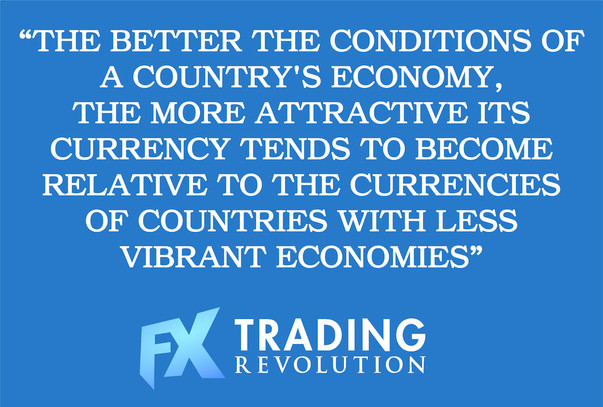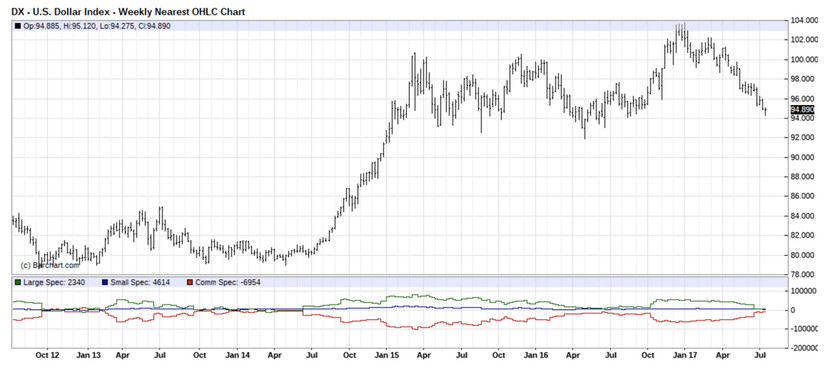How Fundamentals affect the Forex market?
Forex traders will take either a fundamental or a technical approach to their analysis of the currency market. Furthermore, in many cases, a combination of both techniques works extremely well too.
Fundamental analysis basically uses underlying economic factors for both countries to forecast future exchange rates for a currency pair.
The process of assessing each country’s economic prospects is somewhat analogous to how analysts review companies and evaluate stocks, with the difference that the analysis for currency pairs is done by comparing the economy of one country relative to that of the other country.
Essentially, the better the conditions of a nation’s economy, the more attractive the currency becomes in relation to currencies of countries with less vibrant economies.
Traders can then take positions based on their conclusions from the analysis, usually over longer term time horizons. They might also look for higher interest rate currencies in which to invest their extra cash.
In this article, we’ll go through the most important fundamental economic indicators that Forex traders are closely following as well as discuss classical valuation theories and how Forex traders can gauge market sentiment.
Key Fundamental Factors that Forex traders pay attention to
News events, domestic political factors, international geopolitical developments and even natural disasters can all affect currency exchange rates in addition to the economic situation in the country.
However, the state of the economy is usually what determines currency exchange rates over the long run. The following are the most closely watched fundamental indicators which can significantly affect the value of a nation’s currency:
- Gross Domestic Product or GDP: The GDP is the sum of all public and private consumption, business and government spending, investment and net exports that make up the total of a country’s economic activity.
- Unemployment: The level of employment in a nation gives a clear indication of that nation’s economic health and its people’s ability to spend.
- Inflation Rates: The rising cost of goods over time will directly impact interest rates and therefore currency exchange rates. Central banks closely watch inflation rates like CPI and PPI to determine how to adjust monetary policy by either raising or lowering interest rates.
- Interest Rates and Interest Rate Differentials: Interest rate differentials take a significant role in determining the value of one currency versus another. The difference between the interest rates of two countries make up a key component for currency valuation and strongly affect investment. Essentially, the “carry cost” of a currency versus another will affect how attractive the currency is to foreign investment.
- Net Imports/Exports and Capital Flows: The amount of money which flows between two countries will directly affect the relative value of their currencies. In essence, if a country imports more than it exports, the country’s currency will depreciate because importers must sell their currency to purchase foreign goods. The level of foreign investment also plays a major role in the supply/demand equilibrium, and therefore strongly affects the value of a currency in addition to the balance of trade.
- Money Supply: How a country controls its money supply makes up a large part of the valuation of currencies relative to one another since the money supply directly affects both inflation and interest rates. A higher money supply will add to inflation and lower real rates of interest.
- Economic Gauges: The level of a country’s production levels, as well as the spending habits of its population, affect inflation and interest rates, hence they can be important in currency valuation as well.
- Future economic prospects: The country’s economic prospects in relation to other world economies affect the value of its currency, as well as the level of trade both domestically and globally.
Currency Valuation Theories
Evaluating currency exchange rates has traditionally relied upon widely followed economic theories.
These are useful approaches that most often economists apply to evaluate the fair value of a currency pair, but also Forex traders can benefit from them by understanding these classical economic theories.

If the current market price is below fair value then the implications are that the currency pair should rise and if the current price is above fair value then the pair is considered overvalued and it’s expected that the exchange rate will depreciate.
Several of these currency valuation theories are described in further detail in the sections below.
Supply and Demand
The most basic of economic theories, it implies that when the aggregate size of buying interest exceeds that of selling interest, the market will rise. Conversely, it will fall when sellers overwhelm buyers.
While this may be something of an oversimplification, this theory underlies all markets, financial and other markets as well.
Purchasing Power Parity or PPP
Purchasing Power Parity theory states that the level of prices for goods and services should be roughly equal between two countries after exchange rate adjustments.
Based on the premise that the same item should cost the same in one country as another — also known as the Law of One Price — this theory implies that one of the currencies would be over or undervalued depending on the difference in the price of the same item in both countries.
In theory, this would eventually be corrected by arbitrageurs buying the product in the lower cost country to sell it in the higher cost country.
Interest Rate Parity
Interest Rate Parity holds that equivalent financial assets with the same risk factors in different countries should carry the same interest rate after adjusting for exchange rates.
Although the determination of risk in equivalent financial assets can be complicated, this theory is used to price forex forwards, futures, options, and swaps.
Balance of Payments
This economic theory postulates that if a country is running a large current account deficit or surplus, then the country’s currency is either over or undervalued and so the exchange rate must be adjusted accordingly sooner or later.
However, the theory does not always consider all aspects, like for example, some of the factors that are behind the strength in the U.S. Dollar despite the United States running a gigantic current account deficit.

On the other hand, China — which has the world’s largest current account surplus — has maintained its currency artificially low by pegging it to the U.S. Dollar.
The COT Report
Every Friday, the U.S. Commodities Futures Trading Commission (CFTC) releases their Commitment of Traders or COT report for the currency futures contracts held until Tuesday.
This report contains valuable information for traders about the holders of currency futures contracts which can help analysts determine market sentiment.
In particular, the report lists details for markets where twenty or more traders hold positions which approach or exceed the limits for reporting set by the CFTC.
When used as a measure of market sentiment, it can give an analyst useful information on how futures traders are positioned in a given currency.

Groups of Traders
The COT report basically divides traders into two separate groups.
The first group, called Non-Commercials, includes financial institutions, hedge funds, and individual traders. These currency futures market participants are generally those who are motivated to profit through speculation.
The second group listed in the COT report consists of commercial traders. They typically use currency futures to hedge or protect against exchange rate fluctuations risks that can affect their business and profitability.
Using the COT Reports
Perhaps the most useful feature for traders in the CFTC’s weekly report would be the weekly changes in the positions listed.
By gauging how a group of traders’ positions change from week to week, a roughly accurate assessment can be made of how market sentiment is evolving among the various categories of futures and options traders.
This allows a Forex trader using the COT report to establish and close trading positions based on useful guidelines that tend to focus on non-commercial positioning.
For example, if there is a strong trend the market usually goes in the direction of the large speculators as these are mostly trend followers (the green line). However, in the end, the commercial speculators are usually correct, so the more negative commercial speculators are, the higher probability of the uptrend coming to its end, and vice versa.

Fundamental Factors Indicating Market Sentiment
News and economic releases make up the traditional avenues of analysis which traders use to gauge market sentiment.
If indicators in a particular country show that the economy is strengthening more than other nations, by an expanding GDP for example, this will tilt market sentiment in favor of that currency relative to other currencies.
Rising consumer and business confidence survey indexes in a national economy also tend to result in improving market sentiment for that country’s currency.
If subsequent economic numbers for the country then continue to support the previous survey numbers, market sentiment will also tend to continue to favor the currency.
However, market sentiment may change if an economic number that falls short of expectations is released or if consumer confidence reverses significantly and heads towards lower levels. Under both of these circumstances, the strength of the economy may be put in doubt and automatically reverse the sentiment toward the currency of that country.
Gauging market sentiment in the Forex market can be a valuable trading tool if done accurately and used with caution. Market sentiment remains somewhat difficult to pin down because of the ever-changing perceptions in the market.
Furthermore, prices will usually have already discounted the effects of market sentiment before a trader can take advantage of any change as it occurs.
Nevertheless, market sentiment is a highly valuable tool for Forex traders and once sentiment has been determined, the trader can then establish suitable positions with appropriate stop loss and profit target levels.
Using Fundamental Analysis
All the tools that we have described throughout this article affect the perceptions of the biggest Forex traders and therefore affect the exchange rates in the Forex market. Using fundamental analysis usually comes down to forming an overall opinion based on the economic indicators and tools we described which ultimately is either positive or negative toward a given currency.
Forex traders can then try to match currencies toward which they have a positive and negative sentiment and position long on the currency they are positive on against the currency they have a negative opinion of. Positions are usually expressed by shorting or buying the specific currency pair that includes the 2 analyzed currencies.





